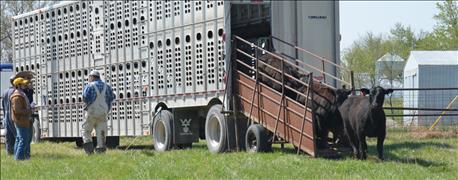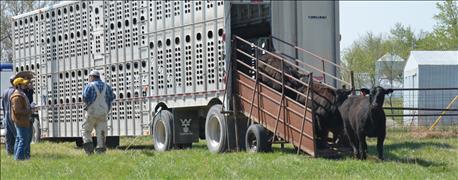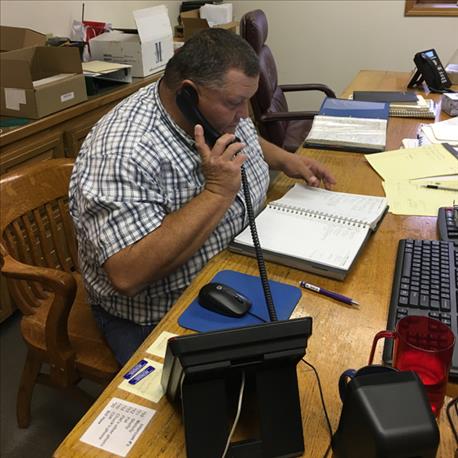November 11, 2016

The days of cattle drives with cowboys on horseback from Texas to the Flint Hills are long gone.
Yet, the demand for “driving” cattle to the nutritious grasslands of the Flint Hills and the Red Hills and to feedlots in western Kansas, Texas, Oklahoma, Colorado and Nebraska is still very much still with us.
It's just now the drivers are on 18 wheels, and the cattle have a comfy ride rather than a grueling experience.
For centuries, the only way to move cattle was by convincing them to walk on their own four legs, prodded by riders on horseback.

UNLOADING TIME: Semitractor cattle trailer rigs coordinated through Livestock Dispatch at Cottonwood Falls haul cattle to Flint Hills pastures in the spring and away to feedlots every fall. (Photo courtesy of Frank Buchman).
A major advancement in moving cattle came with the arrival of trains in the mid-1800s. The trains took cattle from the major railroad town depots at Caldwell, Wichita, Newton, Abilene, Ellsworth and Dodge City to the packing plants in Kansas City and on the East Coast. But cowboys on horseback were still the primary way to take them from cow-calf ranches to backgrounding lots or stocker pastures or from pastures to feedlots.
Eventually, the rail lines were built throughout the Midwest so cattle could be moved more readily into certain locales for grazing, growing, feeding and slaughter.
Every spring, thousands of young, thin cattle would be shipped by train from Texas to railroad yards at Cassoday, Bazaar and many other small communities.
At summer’s end, the fattened cattle were loaded back on trains for shipment to packing houses in the East.
By the mid-20th century, trucks became the major mode of hauling. Today, trucks and trailers of all sizes and shapes are used to transport cattle.

LINING UP TRUCKS: Pat Swift spends many hours a week at his Livestock Dispatch office in Cottonwood Falls lining up trucking logistics for hauling more than 540,000 cattle throughout the Midwest annually. (Photo courtesy of Frank Buchman).
The most economical, efficient method of cattle transportation is in large double-deck semitractor trailer rigs — a common sight on the nation’s highways and byways.
However, logistics are a major part of livestock hauling that most people have never considered. It requires detailed organization and implementation for a complex operation.
Cattle semis have to be at a certain place at an exact time with precise capacity to be loaded with cattle for safe travel and arrival at destination.
That’s where Livestock Dispatch comes in.
“Cattlemen were having a difficult time lining up dependable semis to haul cattle when they needed them. Livestock Dispatch was started 27 years ago to serve that need and purpose,” according to Pat Swift, coordinator for the Livestock Dispatch business, headquartered at Cottonwood Falls.
Dispatch is defined as “sending someone or something quickly to a particular place for a particular purpose.”
Livestock Dispatch does just that: Precise, timely loading of cattle and safely hauling cattle whenever and wherever they need to go and be.
“Transportation is a very important part of the cattle industry. Today, through our organization, cattle are hauled all over the Midwest,” Swift says.
Livestock Dispatch is the brainchild of Tom Gilliam, Tom Dial and Bill Haw and is currently owned by Gilliam.
Swift is joined by Melody Sigel and Shelly Reyer as employees of Livestock Dispatch, coordinating cattle transportation from their Main Street office.
“More than 100 semitractor cattle rigs are coordinated for our work with many individual operators and several large companies,” Swift says. “We spend lots of time on the phone."
Working for Stockman Order Buying, Ranch Management Group, El Coyote Ranch and many small ranchers, Livestock Dispatch coordinates hauling an average of more than 540,000 cattle annually.
“This includes all cattle hauled, feeders and fat cattle,” Swift says.
Lining up cattle trucking throughout Kansas, Oklahoma, Texas, Missouri, Colorado and Nebraska, Livestock Dispatch works closely with Tyson, National Beef, Cargill, Lone Star Beef, Haw Ranch Feedlot, Haw Ranch II and many smaller feedlots.
“The majority of our work is through grazing cattle in the Flint Hills,” Swift says.
Buchman is a rancher and blogger who lives near Council Grove in the Flint Hills.
You May Also Like




